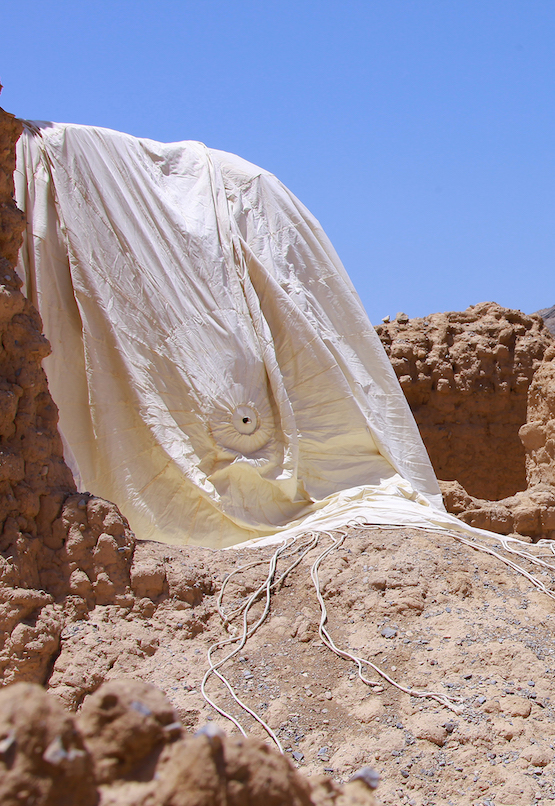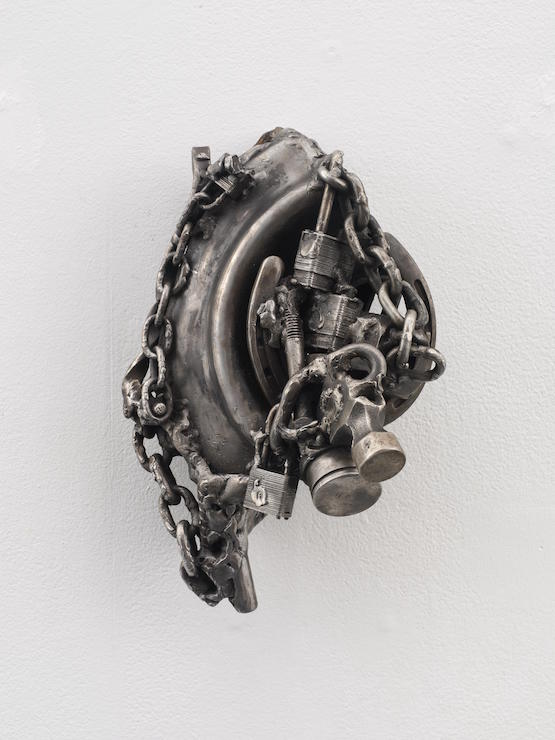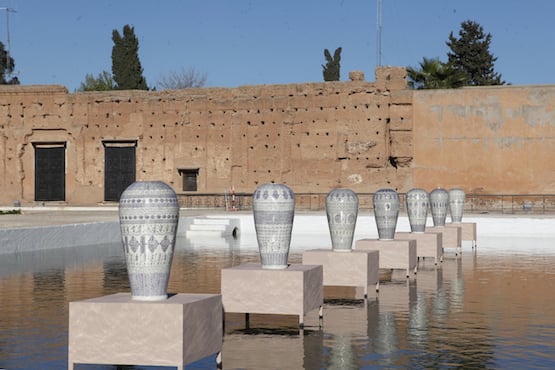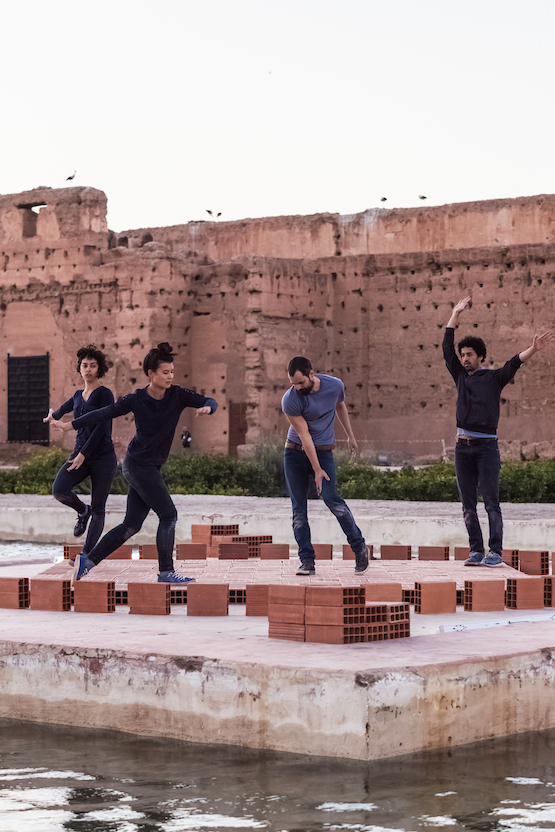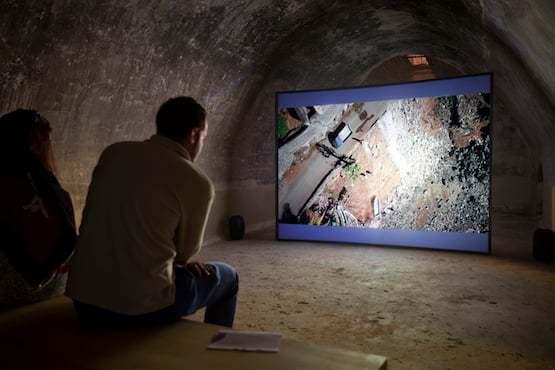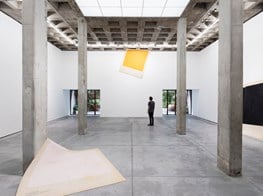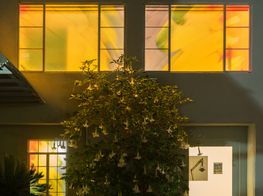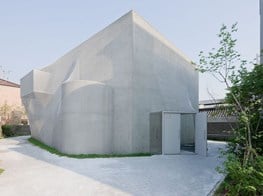Marrakech Biennale 6: NOT NEW NOW

Transculturalism is not a matter of free choice, it is a condition of global exchange that is materially and politically coercive, if also potentially liberating. It is necessary, therefore, to embed the debate in transnational public spheres—the product of contrary developments such as the emergence of postcolonial civil societies on one hand and capitalist globalisation on the other.
—Geeta KapurIn a city of contradictions, where poverty meets affluence, religious tradition meets modernity and the climate succumbs to the extreme temperaments of the desert, one couldn’t expect less from a contemporary art biennale than the placement of contemporary installations embedded in world heritage sites and public places of historical importance. Curated by Reem Fadda (Associate Curator, Middle Eastern Art for the Abu Dhabi Project of the Solomon R. Guggenheim) and assistant curator Ilaria Conti, the 6th edition of the Marrakech Biennale, Not New Now, investigates how development occurs—and has occurred—from within the cultural connection Morocco shares with Africa, the Arab world and Asia.
Through five public sites and one private, the biennale’s lens offers a view of the legacy of artistic resistance, which has channeled and inspired collective movements and practices concerned with issues ranging from decolonisation to exploring survival technologies. Take the biennale’s survey of the Modernist movement instigated by the Casablanca School, or the installation of a sculpture in the Menara Pavilion by Khaled Malas, representative of his project, Current Power in Syria (2016), which involved the architect Malas’ working in collaboration with Syrian villages to build windmills to generate light for the local hospitals. (In two venues, Radhika Khimji’s white parachute, Stay Safe, (2016), expresses the quest of inquiry predicated on a timeless and poetic concern with escapism and freedom).
Radhika Khimji, Parachute, 2010. Canvas, metal eyelets and sailing rope. 8.3 meters in diameter plus ropes of varying lengths. ©Radhika Khimji.Incorporated within the biennale’s premise we also find architectural elements, calligraphy and crafts. These awaken the rich cultural local traditions whose temporal fluidity extends to the contemporary defining a nation and bringing it to life, while carrying with it the voice of the past in defense of the new world’s order. Characteristic of this was the inclusion of work by Djibril Diop Mambety, (1945 – 1998), a prolific Senegalese filmmaker whose experimental films depict sociopolitical conflicts and question post-colonialism in a non-linear format. Despite the fact that his work is positioned in a small room with three screens next to each other playing simultaneously, making it impossible to focus on any one of the feature films, the aesthetic of Africa’s visual past presented in these works operate as a connecting link to tie together the materiality of the contemporary locality to its past.
Bouchra Khalili, Speeches-Chapter 3: Living Labour, 2013. Digital film, 25'. From The Speeches Series, a video trilogy. View of the installation at Living Labour, solo exhibition, PAMM, Miami, 2013. Courtesy of the artist and Galerie Polaris, Paris.The biennale is based on three main themes that roughly follow the nuances of the participating venues: ‘Living Matter’ at Bahia Palace, ‘Living Ruins’ at El Badii Palace, ‘Right and Right’ at the Dar Si Said, and ‘Sites/Sights of Knowledge’ at the Koutoubia Mosque and Menara Pavilion. Bahia Palace, a 19th century opulent construction, is believed to be the property of a wealthy former slave and is famous for its craftsmanship using top of the line materials coming from Italy, Spain and Morocco. The location features courtyard gardens surrounded by rooms where works are installed, including Bouchra Khalili’s Speeches – Chapter 3: Living Labour (2013), Isak Berbic’s Baynunah River (2015), and Melvin Edward’s historic metal sculptures Lynch Fragments (1980 – 2012). The latter work first appeared in the 1960s during the civil riots in the U.S and revolutionised sculpture by incorporating into abstract formalism the notions of memory, politics and identity. Black, metal objects welded in a violent form that cautions danger, the presence of Edward’s sculptures reflect not only on the art historical importance of the work, but also reference a continuity with the past; a continuity that is key in this biennale’s premise of connecting Marrakech with Pan-Africanism and artistic traditions in which the concerns for freedom, equality and human rights have been consistent and maintained throughout.
Melvin Edwards, Libya, 2012. Welded steel. 13.75h x 7.5w x 8d in. Courtesy Alexander Gray Associates, New York; Stephen Friedman Gallery, London. ©2015 Melvin Edwards / Artist's Rights Society (ARS), New York.El Badii Palace, a 16th century ruin with lavish decoration from Portuguese funds, took 25 years to complete and houses works including Rachid Koraichi’s series of large, seven ceramic vases in La prière des absents (2013-2015), on which transcriptions present a personal coding system created from a combination of Hebrew, Arabic and Chinese. Ahmed Mater’s Songs of Cyanosis (2016) presents discarded objects and artifacts from Mecca’s holy city salvaged and exhibited here to comment on the eradication of local traditions in the face of urbanisation. In tune with the context of the ruined palace, the two works present the corresponding theme with which ‘newness’ is interrogated in this exhibition: at once something that comes from a transformation, or reconstitution of the past. Encapsulating this notion was Radouan Mriziga’s performance, 3600 (2016), in the ruined palace. Based on its duration of a choreographed 3,600 seconds’ sequence, four dancers using mud bricks on the bridge of the palace’s lake, take apart the pre-existing geometric formation of the bricks in order to form a different structure similar to the first, embodying symbolic Islamic patterns. The result is a transcending visual experience that collapses the boundaries between mathematical systems, spiritual exercise and performative action and in combination with the context within which it manifests itself, activates the space and its historical significance.
Rachid Koraïchi, from the series: La prière des absents , Prayer for the Absent Ones, 2013 - 2015. Red earth, blue and white oxide, 110 x 53 x 53 cm. Collection Maroc Premium Fondation. Photo © www.jensmartin.com.Connecting architecture and technology with history and space in a symbolic fashion, was the ‘Sites/Sights of Knowledge’ section housed within the Menara Pavilion and Koutoubia Mosque. The 16th century Menara Pavilion is located within the 12th century Menara gardens, which use a sophisticated hydraulic system through which water from the mountains is channeled in an artificial lake that preserves the gardens. The site provided the perfect venue for Khaled Malas’ black symbolic sculptural cross, cross-referencing the windmills forming his project, Current Power in Syria, 2016, mentioned earlier.
Radouan Mriziga, Live performance, February 24-27, 2016, Palais El Badii. Photo © Saad Alami.Similarly connecting with its site is Superflex’s mesmerising film Kwassa Kwassa (2015), which is found in the tombs of the Koutoubia Mosque, located across Marrakech’s main square. The film is centered around the construction of the white fiberglass boats called kwassa and depicts the culture of the Comoro Islands. Filmed in a narrative format and narrated by a local boatbuilder in his dialect, the film portrays the story of the island of Mayotte, which, after having gained its independence from France, voluntarily reversed it in 2014 with a referendum, thus becoming the remotest territory of the European Union and therefore a migration destination for the neighboring islands and parts of east Africa. A poetic look at an ongoing global situation, the film’s depiction of the process of transportation and the carrier of dreams, connects with the spiritual aspect of the mosque and the location of the film’s underground screening drawing on elements of life and death and the journey between.
SUPERFLEX, Exhibition view, Citernes de la Koutoubia, Marrakech. Photo © www.jensmartin.com.Considering the general criticism and scrutiny surrounding the biennale phenomenon and their relationship and relevance to site, production and discourse, it would be safe to say that this biennale’s inclusive, concise and comprehensive effort to connect Marrakech with a complex global dialogue is well-executed. Taking into consideration the global south and its urgency for cultural pluralism as being at the core of contemporary discourse, not only has Fadda managed to successfully reflect and incorporate the global south equally within the presentation of this lateral exercise, but has done so with the well-articulated elegance of an intimate testimony rather than the precariousness of cultural activism and/or the promotion of festivalism associated with biennales. Through its contradicting polarities and with respect to its local cultural realities, this syncretism, Not New Now manages to not only remain relevant while successfully incorporating and encapsulating the vernacular in a non-essentialist manner, but also to activate the spiritual and the political with a subtlety which allows social knowledge to be produced in both an individual and collective manner.
As Nikos Papastergiadis notes, ‘when artists redefine their function as context shifters rather than content providers, they become more intimately involved in the production and mediation of new social knowledge’. Tarek Atoui’s sound performance Conjured Geographies (2016), presented at the Bahia Palace, reflects that statement. Using improvisational circuit bending to integrate traditional voices from classical orchestra using a self-made deck that reacts to the artist’s movements, the performance brought together the immaterial with the tangible. Like the biennale itself, it managed to return art to its basic, all encompassing function of being ‘nothing but the mutual articulation of thought, matter and body’ while collapsing all geographical, temporal and physical boundaries. —[O]

